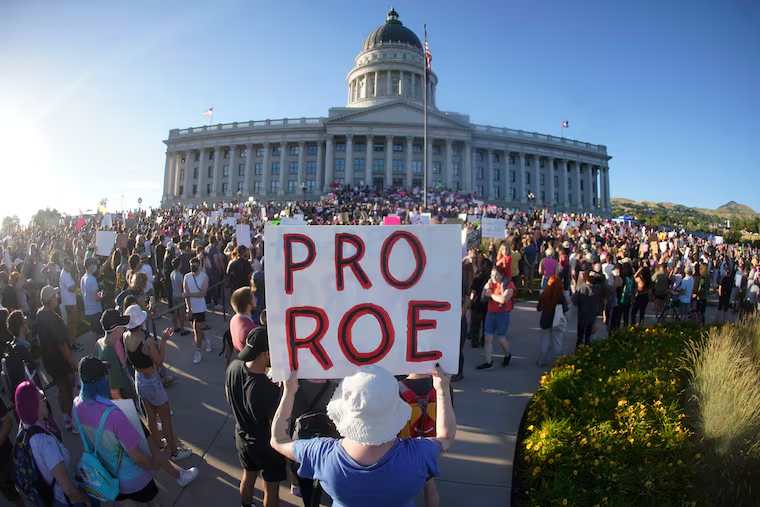Pat Ciarrocchi: ‘Why are we back here in this place?’
When I first heard about the Roe v. Wade decision, I called my longtime friend, who helped found Ms. Magazine 50 years ago. “The fight is not over,” she told me.

When I learned that the Supreme Court had struck down Roe v. Wade, I called a longtime friend and women’s rights advocate who had rallied women’s voices 50 years ago.
Her name is Patricia Carbine. Born in Villanova, Carbine and Gloria Steinem founded Ms. magazine in 1972 — bringing their first regular issue for July to the newsstands on June 24, as Carbine recalled. That’s right, Ms.’s 50th anniversary fell on the same day as the Supreme Court’s ruling. Carbine, now 91 years old, couldn’t help but note the irony.
“Why are we back here in this place?” I asked.
“The fight is not over,” Carbine told me on the phone. “It can’t be.”
“Women may have forgotten,” she said, “that so many women and girls from an earlier age were left to die after botched back-alley abortions.”
But when Ms. first published, the stories of those women were fresh in readers’ minds.
“‘The fight is not over,’ Carbine told me on the phone. ‘It can’t be.’”
Carbine recalled an editorial decision in the spring of 1973 regarding a story about life “before Roe.” It was written as an unvarnished telling of the realities women faced when they wanted or needed to terminate a pregnancy.
Carbine and the other editors decided to include, as part of the story, a graphic photograph of a then-anonymous woman who had died at a Connecticut motel. As reported by Ms. author Roberta Brandes Gratz, the pregnant woman was with her male partner, who was going to help her with an abortion. They were in a motel room, not a medical facility.
The woman — who was later identified as Gerri Santoro — started hemorrhaging. The boyfriend panicked and abandoned her. The photograph shows Santoro’s body on the floor in a pool of blood.
Publishing that picture was a controversial decision — but one Carbine stands by, all these years later.
“Women and men needed to see the reality of what had been,” Carbine told me.
With the Roe decision nearly 50 years ago, Carbine believed the fate of Gerri Santoro and women like her would never happen again.
With this latest ruling, the headline over that picture could now read “Again,” Carbine told me. “It’s a gut punch,” she said.
As a TV reporter, I have covered “pro-life” rallies — listening to protesters chanting “baby killers” while holding up signs with pictures of fetuses. It’s a visceral phrase, and one that haunted me long after the rally was over. As a woman, I mentally clutched the part of me designed to bring forth life.
In covering “pro-choice” rallies, I saw a hint of desperate worry in the eyes of determined women. Would this freedom to choose always be theirs?
I confess: As a Catholic, I have always been troubled by the debate over abortion. The word itself is fraught with emotion. I have imagined the decision to choose to terminate a pregnancy as clearly dizzying. Would the decision to choose to carry a fetus to birth — especially a fetus conceived in crisis — be less dizzying?
The pivotal word in both circumstances is choice.
So as a woman, when I attended pro-choice rallies as a reporter, I found myself mentally raising my fist in solidarity for the choice to freely be the sovereign of my own body. Abortion is a private and sacred choice.
And I began to grieve for the women who had been denied this choice. When Carbine started telling me on the phone about the graphic image she included with an article about life before Roe, I realized with a start that I remembered that image, and that article; I remembered seeing both decades ago, in Ms. magazine.
As a Catholic woman, I imagined what my choice would have been, if I ever had an unwanted pregnancy. But I could never imagine that my doctrinal religious or personal moral choices should dare to be foisted on another woman, under penalty of arrest.
That is not a regulation for “the common good.” That is abuse of power.
Now, and not so suddenly, with the telegraphing that “overturning Roe” was agenda item No. 1 for those holding what’s being labeled as fascism dressed in extreme Christian-right beliefs, abortion is no longer the most emotionally fraught word I’m finding on people’s lips.
It’s choice.
And now, our choices are more critical than at any time in our lives as citizens of the United States and of Pennsylvania.
The Supreme Court decision transfers the decision-making about abortion to individual states. That means that whoever is in Harrisburg matters more than ever before.
We are electing a new governor in November. Gov. Tom Wolf has vowed to keep abortion legal in our state, but his term is ending in January. Josh Shapiro is the Democratic candidate. Republican candidate Doug Mastriano has said he believes that life begins at conception — which is a religious belief held by the Catholic Church. He has sponsored a “heartbeat bill,” which would ban abortion after roughly six weeks, often before a test would confirm a pregnancy.
With Pennsylvania’s open seats for governor and the U.S. Senate, in addition to dozens of other state-level offices, people must choose carefully in order to preserve their own power to choose in all personal, private, and sacred matters.
I confess: I have hope. This fall, vote is another word for hope.
Pat Ciarrocchi was a news anchor on CBS3 for more than 30 years.